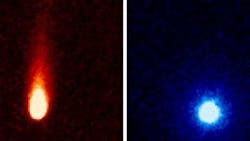Spitzer Space Telescope's images of gas emission from Comet ISON
With its infrared array camera, NASA’s Spitzer Space Telescope captured images of the Comet ISON’s carbon dioxide emissions ahead of its anticipated pass through the inner solar system later this year.
Spitzer’s infrared array camera (IRAC) is one of three focal plane instruments on the telescope. It is designed to detect light and near and mid-infrared wavelengths between 0.6 and 8.0 µm. Unlike a normal camera, says NASA’s Jet Propulsion Laboratory, IRAC has four detectors that each measure light at one particular wavelength. It provides simultaneous 5.2' × 5.2' images at 3.6, 4.5, 5.8, and 8µm. The instrument observes two fields of view simultaneously and all four detector arrays in the camera are 256 x 256 pixels in size, with a pixel size of ~ 1.2" x 1.2".
The two shorter wavelength channels (3.6 and 4.5 µm) have detectors made of indium and antinomy, while the longer wavelength channels 5.8 and 8.0 µm) have detectors specially treated with arsenic.
IRAC was developed by the NASA Goddard Space Flight Center with the Smithsonian Astrophyiscal Observatory having management and scientific responsibilities. Barr Associates (now Materion) produced the camera’s filters, OCL-AJDS Uniphase Co. produced the beam splitters, and Spectral Systems Inc. produced the lenses. In addition, IRAC’s detector arrays were developed by Raytheon.
Comet ISON was about 312 million miles from the sun, 3.35 times farther than Earth, when the observations were made, according to NASA. The comet is believed to be on its first passage from the distant Oort Cloud, a spherical collection of comets and comet-like structures about between one-tenth and 1 light-year away from the sun. It will pass within 724,000 miles of the sun on November 28 of 2013. At the time the images of the comet were captured, ISOn was about 312 million miles (502 million kilometers) from the sun.
Check out a space model of the Comet ISON from Inove.
Read more about NASA’s Comet ISON observing campaign.
Read a technical paper on IRAC.
Also check out:
NASA releases image of Saturn's view of Earth
Largest camera in the world to create 3D map of Milky Way
Multispectral imaging captures views of Mars
Share your vision-related news by contacting James Carroll, Senior Web Editor, Vision Systems Design
To receive news like this in your inbox, click here.
About the Author

James Carroll
Former VSD Editor James Carroll joined the team 2013. Carroll covered machine vision and imaging from numerous angles, including application stories, industry news, market updates, and new products. In addition to writing and editing articles, Carroll managed the Innovators Awards program and webcasts.
